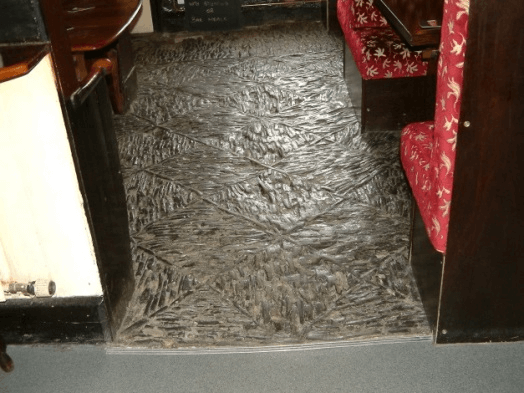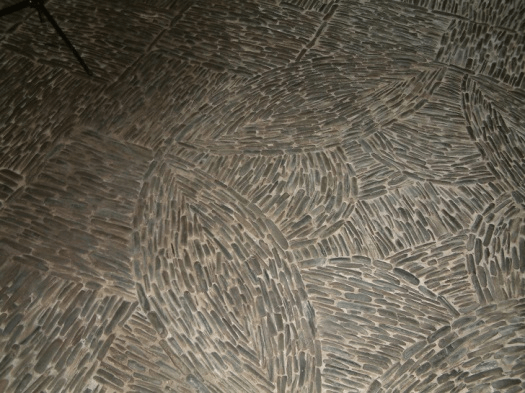Examples of traditional cobbled floors in Mid Wales:


Excerpt from: The Welsh House: A Study in Folk Culture
By Iorwerth C. Peate, Brython Press, Liverpool, 1944
‘Native earth’ was more commonly used throughout Wales for floors than it was even for walls. ‘The floor’, writes J. Evans in 1798 of a cottage near Barmouth (Merionethshire) ‘was the native soil, rendered very hard and uneven from long and unequal pressure’. Culley’s description in 1867 of the ‘ordinary form of cottage in South Wales’ proceeds: ‘The floor is usually of mud or puddled clay.’ The present writer’s own home had such a floor in its kitchen at the end of the 19th century and, describing the cottages of west Montgomeryshire in the 19th century, David Peate observes: ‘Almost without exception, they had earthen floors, a few rough stones being placed on the hearth’. Mr Sam Ellis describes certain farmhouses in the Garthbeibio district of Montgomeryshire in the late 19th century: ‘Tynsietin had an earthen floor with thick stones on the hearth. It seems to me that the feet of generations and the broom of the housewife had worn the kitchen-floor until the hearth was on a somewhat higher level. I remember going there as a boy one night and sitting on a three-legged stool. The stool turned over and I fell backwards.
[...]
In parts of Caernarvonshire, the hard earthen floors were washed with water containing soot, which in time gave them a smooth shiny surface. On the hearth, white stones were used or decorations made with clay formed into small balls. This clay was dug in the Holyhead district and in Llŷn and sold in Caernarvonshire. These clay balls (or often dock leaves) were used for marking patterns, and such patterns were always to be found around the dresser and the long-case clock in districts such as Bethel, Caernarvonshire. This custom of decorating floors of all kinds with geometrical patterns was found throughout Wales: the patterns were applied generally by the use of ‘hearthstone’ – a kind of whiting – and were renewed daily or at each washing of the floor. Another type of flooring met with southwest Wales was a mixture of earth and lime, which properly mixed formed a good floor with a smooth glazed surface. In some cases, bullocks’ blood was added. The floor at Plas Watford, near Caerphilly, Glamorganshire, affords a good example of this type.
Giraldus Cambrensis has described how the floors of the medieval houses were covered with rushes and green grass on which meals were partaken. [...] Mr Ffrancis Payne informs me that brick and stone floors were so strewn in parts of Radnorshire during his boyhood as tavern floors are still strewn with sawdust. The practice of using rushes also continued in the churches of Wales until a comparatively late date. John Evans (1798) describing the church at Mallwyd (Merioniethshire) writes that ‘the floor [was] covered with rushes, a practice almost universal through Wales’. Cradock found that in 1776 the floor of Dolgelley (Merionethshire) church ‘is only clay covered deep with rushes’.
Mr Evan Rowlands of Llanllyfni, Caernarvonshire, informs me that in his district he remembers – sixty years ago – the earthen floors being sanded, and that this was known to him in the Rhondda Valley (Glamorganshire) as recently as twenty years ago. The practice was indeed widespread.
In the eastern half of Montgomeryshire where the half-timbered technique is normal, there are floors of attractive construction and design. These are the well-known ‘pitched’ floors formed of small stones or pebbles set on edge, cobble wise, forming geometrical patterns. These floors are now rapidly being destroyed. I found that housewives complained of the difficulty of keeping them clean, others – sunt lachrymae rerum! – wished to cover their floors with linoleum and the stones cut through it in a short time. Scores of these floors have therefore been torn up and relaid with tiles. As for the distribution of the pitching-technique, it is found in exterior work and in stables etc., over a large area and is not confined to Wales. In house-floors, this technique is found in Montgomeryshire, Carmarthenshire and Cardiganshire. Further inquiry may possibly reveal a wider distribution. Wright in his references to the word ‘pitch’, gives as a definition ‘to pave with small uneven stones set up edgeways’ and quotes its use from other English counties. It is obvious however that in several of these counties, the term is used for external paving but a quotation from west Somersetshire (‘Will ‘ee have the floor a-put in way brick or else will ‘ee hab’m a-pitcht?’) may indicate that such floors are also known there.
M.F.H.Lloyd describing Abernodwydd, Llangadfan, Montgomeryshire, writes: ‘All rooms on the ground floor are paved with cobbles; this carefully executed floor is an interesting example remaining practically entire’. I noticed when I visited the house that the initials of the pitcher are worked in the floor in white pebbles. Plasau Duon, Llanwnnog, Montgomeryshire, was described in 1904. It was then stated that ‘the floor of the kitchen is paved with small stones set edgewise in squares of alternate patterns, with a circle in the centre of the room enclosing a diamond square similarly treated’. [...]
Flag-stones were introduced in many areas where local supplies were available and such supplies ‘overflowed’ into neighbouring districts. The slate quarries of north Wales for instance provided flooring for a large area and in some parts of the north-Wales counties flagstone flooring was – and still is – a normal feature.